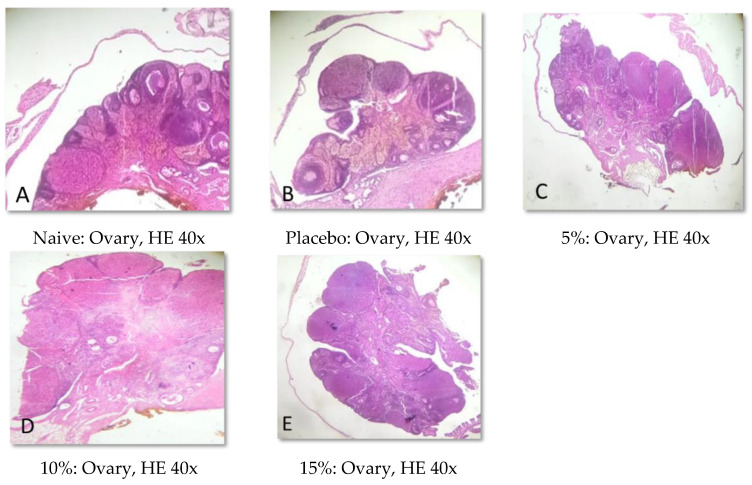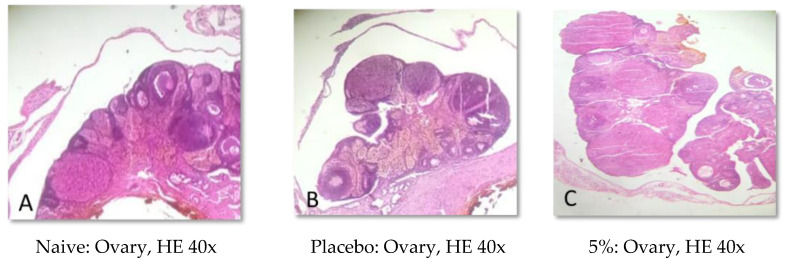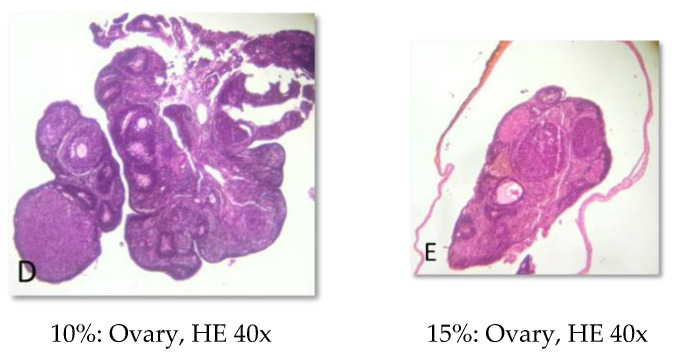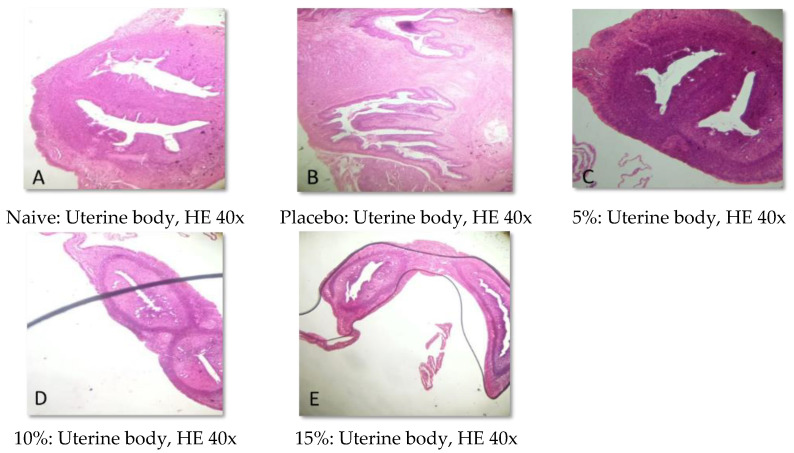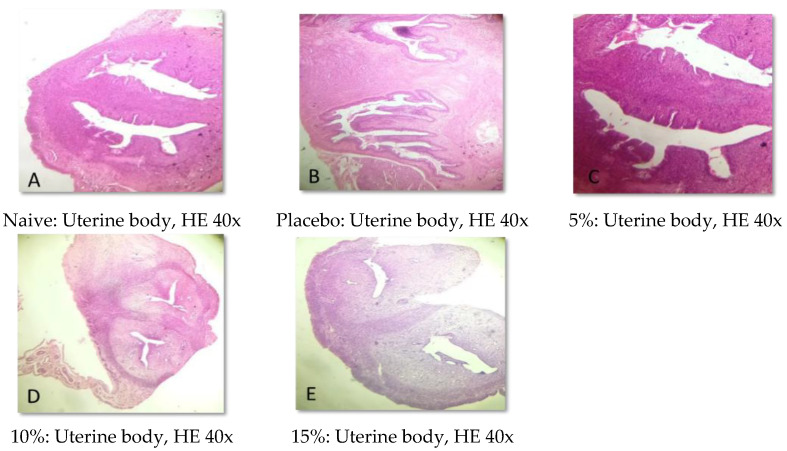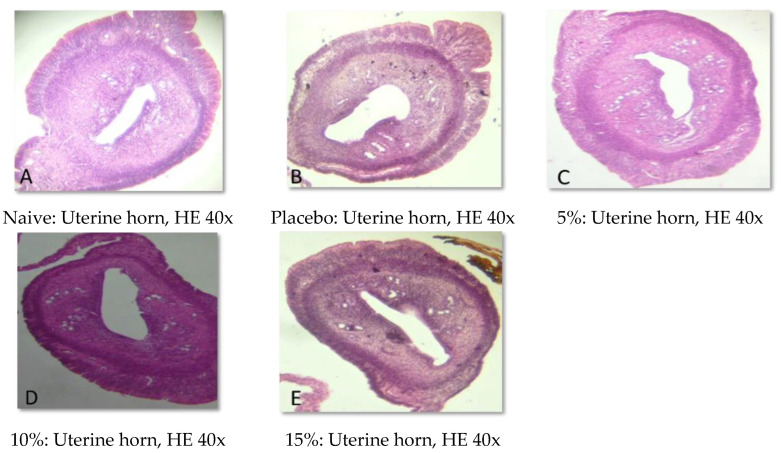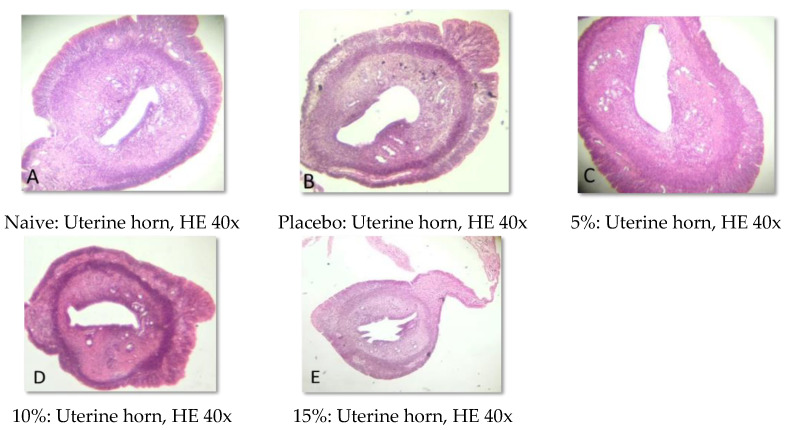Abstract
Medicinal plants have great prominence in research into the development of new medicines. Eugenia uniflora L. (Myrtaceae) is an edible and medicinal plant with economic value in the northeast region of Brazil. Several preparations from E. uniflora leaves and its fruits are employed as a source of nutrients and bioactive compounds. In this study we evaluated the preclinical toxicology of crude extract and vaginal gel obtained from the leaves of E. uniflora (5%, 10%, and 15%) aiming to provide safety for its use in the treatment of vulvovaginitis. Both formulations were applied to the vaginal cavity for 14 days. Detailed observations of the vaginal region, including pruritus, swelling, irritation, burning, pain, and vaginal secretion, as well as the estrous cycle were evaluated. On the fifth day, blood samples were obtained from the supraorbital plexus for biochemical and hematological analyses. The animals were subsequently euthanized. All animals underwent necropsy and macroscopic examination of the vaginal mucosa and reproductive system. A histological examination was also performed. No clinically significant changes were detected during the entire experimental period. All biochemical, hematological, or histopathological parameters were within the normal range for the species. The data obtained allow us to suggest that the E. uniflora vaginal formulations are safe in this experimental model.
Keywords: medicinal plants, pitanga, toxicity
1. Introduction
Medicinal plants have been a therapeutic alternative for thousands of years, mainly in Middle Eastern countries and Asia. Historically, several species were used in the treatment of several health disorders, the prevention of epidemics, and in microbial and antifungal control [1,2,3]. Brazil has an excellent tradition in the use of different natural products, due mainly to the large diversity in plant species in their natural biomes [4]. In general, traditional preparations from medicinal plants concentrate many metabolites [5], which, despite their effectiveness, can cause significant adverse effects [6,7,8].
Among the Brazilian species with medicinal properties, Eugenia uniflora L. (Myrtaceae) stands out. In Brazil, the fruits of E. uniflora are consumed in natura, but their main use is in the industrial and domestic preparation of pulps and juices. The species can also be used in the manufacture of ice cream, refreshments, jellies, liqueurs, and wine [4]. In the 15th century, the species was included in traditional medicine by the Guarani Indians. Popularly, it is used in the form of decoction or infusion in the treatment of hypertension, as well as gastric and digestive disorders. Moreover, the consumption of its leaves and fruits showed anti-inflammatory, antioxidant, analgesic, antibacterial, and antifungal effects [4,5,9,10,11]. Several secondary metabolites were described for E. uniflora. Recently, Souza et al. [12] characterized the presence of several flavonoids, tannins, and terpenes in crude extracts and volatile oil from E. uniflora leaves, including selina-1,3,7(11)-trien-8-one, oxidoselina-1,3,7(11)-trien-8-one, germacrene B, curzerene, β-caryophyllene, germacrone, and β-elemene, which were related to their pharmacological activities.
Diseases of the genital tract, such as bacterial vaginosis, candidiasis, vulvovaginitis, and chlamydia, affect women of all ages by altering the local microbiota, raising the pH, and causing discharge, edema, and vaginal odor [11,13]. In Brazil, plants such as Schinus terebinthifolius Raddi (“Aroeira”), Stryphnodendron barbatimam Mart. (“Barbatimão”), and Anacardium occidentale L. (“Caju”) showed beneficial properties for the treatment of diseases of the gynecological tracts, being even recommended by the Ministry of Health [14,15]. It is worth noting that many studies with different preparations obtained from medicinal plants showed significant effects against several pathogens including Staphylococcus aureus, Listeria monocytogenes, Bacillus subtilis, Streptococcus faecalis, Staphylococcus epidermidis, as well as resistant strains of Candida albicans [11,16]. Thus, in this study we investigated the pre-clinical toxicological of two vaginal formulations obtained from the leaves of E. uniflora, aiming to provide safety for its use in the treatment of vulvovaginitis.
2. Results
2.1. Clinical and Behavioral Observations
During the 14-day period of experimentation, the animals did not show any clinical or behavioral signs of toxicity, including weight loss (Table 1 and Table 2), piloerection, itching, or secretion or edema in the vaginal region. The estrous cycle was regular in all experimental groups, with 4–5 days (Table 1 and Table 2) of duration and without significant cellular morphological changes.
Table 1.
Body weight, length of estrous cycle, and relative organ weight of the different experimental groups at the end of 14 days of topical vaginal treatment with gel formulation (5, 10 and 15%) from E. uniflora.
| Parameter | Naive | Placebo | 5% | 10% | 15% |
|---|---|---|---|---|---|
| Body weight (g) | 218 ± 6.3 | 221 ± 7.2 | 219 ± 6.9 | 220 ± 7.7 | 222 ± 7.1 |
| Estrous cycle (days) | 4.7 ± 0.3 | 4.6 ± 0.2 | 4.6 ± 0.3 | 4.8 ± 0.3 | 4.7 ± 0.2 |
| Liver (%) | 3.79 ± 0.11 | 3.52 ± 0.10 | 3.70 ± 0.05 | 3.51 ± 0.12 | 3.32 ± 0.20 |
| Spleen (%) | 0.25 ± 0.01 | 0.24 ± 0.01 | 0.25 ± 0.01 | 0.24 ± 0.01 | 0.24 ± 0.01 |
| Kidneys (%) | 0.42 ± 0.01 | 0.41 ± 0.01 | 0.40 ± 0.01 | 0.39 ± 0.01 | 0.41 ± 0.02 |
| Reproductive organs (%) | 0.22 ± 0.02 | 0.22 ± 0.02 | 0.19 ± 0.01 | 0.23 ± 0.01 | 0.24 ± 0.03 |
Statistical analyses were performed using one–way ANOVA followed by Bonferroni’s post-hoc test. Values are expressed as mean ± SEM (standard error of the mean). n = seven rats per group.
Table 2.
Body weight, length of estrous cycle, and relative organ weight of the different experimental groups at the end of 14 days of topical vaginal treatment with crude extract (5, 10 and 15%) from E. uniflora.
| Parameter | Naive | Placebo | 5% | 10% | 15% |
|---|---|---|---|---|---|
| Body weight (g) | 220 ± 5.2 | 219 ± 6.1 | 221 ± 7.0 | 219 ± 6.4 | 219 ± 6.6 |
| Estrous cycle (days) | 4.6 ± 0.3 | 4.7 ± 0.3 | 4.6 ± 0.2 | 4.7 ± 0.3 | 4.8 ± 0.2 |
| Liver (%) | 3.79 ± 0.11 | 3.52 ± 0.10 | 3.61 ± 0.14 | 3.44 ± 0.07 | 3.87 ± 0.12 |
| Spleen (%) | 0.25 ± 0.01 | 0.24 ± 0.01 | 0.23 ± 0.01 | 0.25 ± 0.01 | 0.24 ± 0.01 |
| Kidneys (%) | 0.42 ± 0.01 | 0.41 ± 0.01 | 0.40 ± 0.01 | 0.42 ± 0.02 | 0.39 ± 0.01 |
| Reproductive organs (%) | 0.22 ± 0.02 | 0.22 ± 0.02 | 0.21 ± 0.01 | 0.22 ± 0.02 | 0.20 ± 0.01 |
Statistical analyses were performed using one–way ANOVA followed by Bonferroni’s post-hoc test. Values are expressed as mean ± SEM (standard error of the mean). n = seven rats per group.
2.2. Relative Organ Weight
Relative weights of organs of the different experimental groups at the end of 14 days of topical vaginal treatment are shown in Table 1 and Table 2. The relative weight of the liver, kidneys, spleen, and reproductive system (ovaries, uterus, and vaginal cavity) did not show any significant change after the application of both formulations when compared to the control groups.
2.3. Hematological Parameters
Hematological parameters of the different experimental groups at the end of 14 days of topical vaginal treatment are shown in Table 3 and Table 4. No significant hematological changes were observed among all experimental groups
Table 3.
Hematological parameters of the different experimental groups at the end of 14 days of topical vaginal treatment with gel formulation (5, 10 and 15%) from E. uniflora.
| Parameter | Naive | Placebo | 5% | 10% | 15% |
|---|---|---|---|---|---|
| Red blood cells (mm3) | 3.7 ± 0.9 | 5.3 ± 0.2 | 3.7 ± 0.9 | 5.1 ± 0.1 | 4.0 ±1.0 |
| Hemoglobin (g/dL) | 7.9 ± 2.0 | 11.6 ± 0.1 | 8.3 ± 2.1 | 11.7 ± 0.3 | 8.5 ± 2.2 |
| Hematocrit (%) | 21.6 ± 5.5 | 30.1 ± 5.1 | 22.1 ± 5.8 | 29.6 ± 4.6 | 22.4 ± 5.5 |
| MCV (µm3) | 41.5 ± 10.4 | 56.4 ± 8.8 | 41.5 ± 10.7 | 57.5 ± 9.5 | 40.1 ± 10.0 |
| HCM (pg) | 15.1 ± 3.4 | 21.9 ± 0.5 | 15.8 ± 4.0 | 22.8 ± 4.6 | 15.4 ± 4.2 |
| CHCM (g/dL) | 26.1 ± 6.1 | 34.8 ± 7.8 | 27.0 ± 6.9 | 39.7 ± 8.0 | 27.5 ± 7.4 |
| Platelets (mm3) | 241.5 ± 65.2 | 277.0 ± 56.4 | 255.6 ± 69.5 | 294.3 ± 49.5 | 239.3 ± 64.0 |
| Monocytes (mm3) | 142.1 ± 40.0 | 105.1 ± 42.0 | 120.3 ± 76.4 | 154.4 ±39.9 | 128.1 ± 61.0 |
| Segmented (mm3) | 1448.2 ± 465.0 | 1214.2 ± 446.0 | 1102.90 ± 278.5 | 1397.1 ± 352.8 | 1121.2 ± 297.3 |
| Lymphocytes (mm3) | 1904.1 ± 605.0 | 2390.3 ± 661.3 | 2278.2 ± 854.1 | 1606.2 ± 631.0 | 1697.3± 752.2 |
| Eosinophils (mm3) | 3.2 ± 2.2 | 3.7 ± 2.6 | 3.14 ± 2.1 | 0 | 0 |
Statistical analyses were performed using one–way ANOVA followed by Bonferroni’s post-hoc test. Values are expressed as mean ± SEM (standard error of the mean). n = seven rats per group.
Table 4.
Hematological parameters of the different experimental groups at the end of 14 days of topical vaginal treatment with crude extract (5, 10 and 15%) from E. uniflora.
| Parameter | Naive | Placebo | 5% | 10% | 15% |
|---|---|---|---|---|---|
| Red blood cells (mm3) | 3.7 ± 0.9 | 5.3 ± 0.5 | 5.2 ± 0.1 | 4.5 ± 0.7 | 5.0 ± 0.8 |
| Hemoglobin (g/dL) | 11.2 ± 2.0 | 11.6 ± 1.3 | 12.1 ± 2.3 | 10.3 ± 1.7 | 11.0 ± 1.8 |
| Hematocrit (%) | 27.9 ± 5.5 | 30.1 ± 1.3 | 30.1 ± 2.7 | 25.6 ± 2.3 | 26.6 ± 4.4 |
| MCV (µm3) | 41.7 ± 7.4 | 46.4 ± 8.8 | 57.0 ± 9.9 | 48.1 ± 8.1 | 45.4 ± 7.5 |
| HCM (pg) | 17.9 ± 3.4 | 21.9 ± 3.5 | 23.0 ± 2.6 | 19.4 ± 3.3 | 18.7 ± 3.1 |
| CHCM (g/dL) | 36.6 ± 6.8 | 38.8 ± 6.8 | 40.4 ± 5.9 | 34.7 ± 6.0 | 35.5 ± 5.9 |
| Platelets (mm3) | 281.0 ± 65.8 | 317.0 ± 46.4 | 293.6 ± 45.3 | 291.4 ± 56.8 | 300.0 ± 57.9 |
| Monocytes (mm3) | 142.1 ± 20.3 | 151.2 ± 28.0 | 145.1 ± 32.8 | 139.2 ± 29.1 | 135.2 ± 36.1 |
| Segmented (mm3) | 1448.1 ± 365.5 | 1214.1 ± 346.0 | 1268.2 ± 310.7 | 1290.4 ± 342.7 | 1263.6 ± 200.8 |
| Lymphocytes (mm3) | 3904.2 ± 605.1 | 4190.1 ± 661.3 | 3913.1 ± 599.7 | 3942.1 ± 570.3 | 4128.1 ± 622.9 |
| Eosinophils (mm3) | 2.2 ± 1.2 | 3.1 ± 2.6 | 0 | 2.4 ± 1.4 | 0 |
Statistical analyses were performed using one–way ANOVA followed by Bonferroni’s post-hoc test. Values are expressed as mean ± SEM (standard error of the mean). n = seven rats per group.
2.4. Biochemical Data
Biochemical parameters of the different experimental groups at the end of 14 days of topical vaginal treatment are shown in Table 5 and Table 6. Statistical analyses did not show any significant lateralization when we compared the groups treated with the different controls used.
Table 5.
Biochemical parameters of the different experimental groups at the end of 14 days of topical vaginal treatment with gel formulation (5, 10 and 15%) from E. uniflora.
| Parameter | Naive | Placebo | 5% | 10% | 15% |
|---|---|---|---|---|---|
| Total protein (g/dL) | 6.14 ± 0.51 | 6.33 ± 1.11 | 6.32 ± 0.55 | 6.34 ± 0.62 | 6.31 ± 0.55 |
| Albumin (g/dL) | 4.11 ± 0.32 | 3.99 ± 0.66 | 3.87 ± 0.78 | 4.01 ± 0.40 | 4.04 ± 0.69 |
| Globulin (g/dL) | 2.33 ± 0.23 | 2.23 ± 0.33 | 2.40 ± 0.29 | 2.42 ± 0.39 | 2.28 ± 0.39 |
| AST (U/L) | 126.73 ± 41.23 | 121.66 ± 55.42 | 130.22 ± 41.23 | 120.12 ± 41.74 | 131.33 ± 41.23 |
| ALT (U/L) | 55.57 ± 11.20 | 61.12 ± 8.30 | 51.5 ± 9.98 | 49.15 ± 10.53 | 59.17 ± 11.30 |
| GGT (U/L) | 1.52 ± 0.54 | 1.47 ± 0.58 | 1.55 ± 0.69 | 1.67 ± 0.66 | 1.62 ± 0.64 |
| AP (U/L) | 104.15 ± 55.22 | 112.34 ± 47.49 | 114.6 ± 42.27 | 111.13 ± 54.45 | 115.15 ± 75.12 |
| TB (mg/dL) | 0.047 ± 0.017 | 0.046 ± 0.017 | 0.049 ± 0.016 | 0.050 ± 0.020 | 0.049 ± 0.019 |
| TG (mg/dL) | 77.12 ± 7.01 | 71.22 ± 8.12 | 69.22 ± 9.03 | 73.11 ± 8.76 | 69.72 ± 9.11 |
| TC (mg/dL) | 60.17 ± 11.02 | 61.57 ± 10.04 | 59.11 ± 9.02 | 60.25 ± 8.12 | 68.17 ± 10.02 |
| HDL-C (mg/dL) | 28.22 ± 6.14 | 30.29 ± 7.11 | 32.37 ± 9.11 | 30.71 ± 9.21 | 29.11 ± 8.84 |
| VLDL-C (mg/dL) | 13.12 ± 3.12 | 12.11 ± 3.01 | 11.44 ± 4.01 | 11.04 ± 3.42 | 10.82 ± 3.99 |
| LDL-C (mg/dL) | 21.11 ± 3.23 | 25.33 ± 4.11 | 26.13 ± 5.03 | 24.21 ± 3.99 | 22.22 ± 2.83 |
| Creatinine (mg/dL) | 0.33 ± 0.08 | 0.35 ± 0.09 | 0.39 ± 0.06 | 0.39 ± 0.07 | 0.34 ± 0.08 |
| Urea (mg/dL) | 50.01 ± 8.31 | 48.12 ± 6.99 | 50.99 ± 7.78 | 53.07 ± 9.11 | 52.06 ± 10.40 |
| Progesterone (pg/mL) | 28.06 ± 7.34 | 30.11 ± 6.16 | 26.99 ± 8.79 | 33.31 ± 9.32 | 29.11 ± 7.65 |
| Estradiol (pg/mL) | 47.22 ± 11.23 | 54.55 ± 12.21 | 55.33 ± 10.09 | 50.12 ± 10.21 | 45.22 ± 11.33 |
| Free T3 (ng/mL) | 0.52 ± 0.11 | 0.55 ± 0.10 | 0.53 ± 0.09 | 0.48 ± 0.09 | 0.51 ± 0.11 |
| TSH (ng/mL) | 4.71 ± 0.70 | 5.02 ± 0.72 | 4.99 ± 0.55 | 5.11 ± 0.99 | 4.95 ± 0.79 |
Statistical analyses were performed using one–way ANOVA followed by Bonferroni’s post-hoc test. Values are expressed as mean ± SEM (standard error of the mean). n = seven rats per group.
Table 6.
Biochemical parameters of the different experimental groups at the end of 14 days of topical vaginal treatment with crude extract (5, 10 and 15%) from E. uniflora.
| Parameter | Naive | Placebo | 5% | 10% | 15% |
|---|---|---|---|---|---|
| Total protein (g/dL) | 6.14 ± 0.51 | 6.33 ± 1.11 | 6.33 ± 0.99 | 6.51 ± 0.97 | 6.61 ± 0.66 |
| Albumin (g/dL) | 4.11 ± 0.32 | 3.99 ± 0.66 | 3.92 ± 0.55 | 3.87 ± 0.77 | 4.02 ± 0.44 |
| Globulin (g/dL) | 2.33 ± 0.23 | 2.23 ± 0.33 | 2.45 ± 0.40 | 2.37 ± 0.33 | 2.24 ± 0.41 |
| AST (U/L) | 126.73 ± 41.23 | 121.66 ± 55.42 | 126.16 ± 56.56 | 120.42 ± 56.65 | 141.23 ± 42.31 |
| ALT (U/L) | 55.57 ± 11.20 | 61.12 ± 8.30 | 53.5 ± 9.98 | 52.65 ± 10.56 | 55.77 ± 11.20 |
| GGT (U/L) | 1.52 ± 0.54 | 1.47 ± 0.58 | 1.55 ± 0.59 | 1.57 ± 0.61 | 1.61 ± 0.54 |
| AP (U/L) | 104.15 ± 55.22 | 112.34 ± 47.49 | 114.10 ± 44.17 | 110.42 ± 51.15 | 109.15 ± 49.29 |
| TB (mg/dL) | 0.047 ± 0.017 | 0.046 ± 0.017 | 0.048 ± 0.019 | 0.049 ± 0.020 | 0.047 ± 0.017 |
| TG (mg/dL) | 77.12 ± 7.01 | 71.22 ± 8.12 | 70.77 ± 8.21 | 68.99 ± 9.99 | 68.19 ± 8.89 |
| TC (mg/dL) | 60.17 ± 11.02 | 61.57 ± 10.04 | 67 ± 8.02 | 66.15 ± 8.19 | 69.17 ± 10.22 |
| HDL-C (mg/dL) | 28.22 ± 6.14 | 30.29 ± 7.11 | 35.66 ± 9.99 | 32.77 ± 7.54 | 27.55 ± 5.55 |
| VLDL-C (mg/dL) | 13.12 ± 3.12 | 12.11 ± 3.01 | 12.14 ± 2.99 | 13.09 ± 3.99 | 14.82 ± 4.22 |
| LDL-C (mg/dL) | 21.11 ± 3.23 | 25.33 ± 4.11 | 24.13 ± 5.02 | 23.11 ± 4.99 | 20.92 ± 4.12 |
| Creatinine (mg/dL) | 0.33 ± 0.08 | 0.35 ± 0.09 | 0.39 ± 0.07 | 0.37 ± 0.08 | 0.36 ± 0.09 |
| Urea (mg/dL) | 50.01 ± 8.31 | 48.12 ± 6.99 | 49.22 ± 8.43 | 50.07 ± 9.31 | 52.66 ± 9.66 |
| Progesterone (pg/mL) | 28.06 ± 7.34 | 30.11 ± 6.16 | 30.22 ± 8.11 | 33.07 ± 9.31 | 28.21 ± 8.31 |
| Estradiol (pg/mL) | 47.22 ± 11.23 | 54.55 ± 12.21 | 52.01 ± 10.99 | 48.98 ± 8.99 | 45.22 ± 11.21 |
| Free T3 (ng/mL) | 0.52 ± 0.11 | 0.55 ± 0.10 | 0.52 ± 0.10 | 0.52 ± 0.10 | 0.53 ± 0.11 |
| TSH (ng/mL) | 4.71 ± 0.70 | 5.02 ± 0.72 | 4.93 ± 0.77 | 5.01 ± 0.89 | 4.98 ± 0.88 |
Statistical analyses were performed using one–way ANOVA followed by Bonferroni’s post-hoc test. Values are expressed as mean ± SEM (standard error of the mean). n = seven rats per group.
2.5. Histopathological Analysis
Representative photomicrographs of ovaries, the uterine body, and the uterine horn are presented in Figure 1, Figure 2, Figure 3, Figure 4, Figure 5 and Figure 6. No significant structural changes were observed between all experimental groups, including apoptosis, necrosis, inflammation, or cellular disarrangement.
Figure 1.
Representative photomicrographs of the ovaries of Wistar rats submitted to vaginal treatment with gel formulation of Eugenia uniflora for 14 days. Hematoxylin and Eosin stain.
Figure 2.
Representative photomicrographs of the ovaries of Wistar rats submitted to vaginal treatment with crude extract of Eugenia uniflora for 14 days. Hematoxylin and Eosin stain.
Figure 3.
Representative photomicrographs of the uterine body of Wistar rats submitted to vaginal treatment with gel formulation of Eugenia uniflora for 14 days. Hematoxylin and Eosin stain.
Figure 4.
Representative photomicrographs of the uterine body of Wistar rats submitted to vaginal treatment with crude extract of Eugenia uniflora for 14 days. Hematoxylin and Eosin stain.
Figure 5.
Representative photomicrographs of the uterine horn of Wistar rats submitted to vaginal treatment with gel formulation of Eugenia uniflora for 14 days. Hematoxylin and Eosin stain.
Figure 6.
Representative photomicrographs of the uterine horn of Wistar rats submitted to vaginal treatment with crude extract of Eugenia uniflora for 14 days. Hematoxylin and Eosin stain.
3. Discussion
Previous studies have shown several beneficial activities of different formulations of Eugenia uniflora, including bactericidal, anti-inflammatory, antifungal, and antioxidant effects [4,5,9,10,11,17,18]. Thus, due to the perspective of its topical application in the vaginal region, safety studies are necessary to prove that the extract does not induce deleterious effects in the application site, as well as changes in clinical parameters and in the structures of hormone-responsive organs. In our study, different formulations obtained from E. uniflora leaves did not present any systemic clinical signs of toxicity, nor did they induce local edema, pruritus, pain, secretion, bleeding, or mucous plug in the vaginal region after 14 days of treatment.
The female reproductive system has excellent blood irrigation due to high local vascularization, which can significantly facilitate the systemic absorption of numerous locally applied drugs [19,20]. Therefore, safety studies of vaginal formulations comprise, in addition to the direct assessment of the site of administration, a set of parameters that may indicate signs of systemic toxicity. Among the data to be evaluated is the relative weight of the organs, which may increase under conditions of chemical or metabolic stress [21,22]. In addition, serum markers of the hepatic, pancreatic, renal, and endocrine functions may indicate biochemical changes resulting from aggression or work overload for the liver, pancreas, kidneys, as well as the hypothalamic–pituitary–ovarian axis [23,24]. In addition, the evaluation of blood cell production is also worth mentioning, as highly toxic compounds can affect bone marrow and hematopoiesis [21,22]. Both the crude extract and the vaginal gel obtained from E. uniflora did not cause any significant systemic changes, as all physical, hematological, and biochemical markers as well as the female sex hormones remained unchanged.
In addition to evaluating the visible effects on the vaginal mucosa, there was a concern about a possible change in vaginal, ovarian, and uterine morphology. In all reproductive organs evaluated, we did not identify any significant morphological changes that could indicate signs of inflammation, degeneration, apoptosis, necrosis, or any adaptation disorders, suggesting a maintained anatomical structure when compared to animals that did not receive any treatment or that were treated only with the vehicle.
In Brazil, several medicinal species are popularly used for the treatment of vulvovaginitis. One of the most relevant is Stryphnodendron spp., popularly known as “barbatimão” [25]. In fact, several vaginal pathogenic yeasts can be treated with the stem bark of this species [26]. Despite the benefits, seed extracts of S. adstringens and S. polyphyllum showed an abortive effect on female rats [27]. In this sense, it is imperative that species popularly used for the treatment of vulvovaginitis undergo a rigorous safety assessment.
Data are available on the toxicological evaluation of different preparations of E. uniflora. Assunção Ferreira et al. [22] performed acute and repeated dose toxicity studies and a genotoxicity evaluation with the aqueous extract obtained from E. uniflora leaves. This preparation, rich in phenolic compounds such as gallic acid, ellagic acid, and myricetin, showed non-toxic and non-genotoxic effects in rodents. In addition, the hepatoprotective effects of the ethyl acetate extract from E. uniflora leaves have already been described, which may indicate additional clinical aspects of the low toxicity of the species [23]. Thus, our study complements the scientific data on the safety of E. uniflora preparations and helps to form a knowledge base for the development of new herbal medicine.
4. Materials and Methods
4.1. Plant Material and Crude Extract Preparation
Leaves of E. uniflora were collected and identified by the Instituto Agronômico de Pernambuco (IPA). The crude extract was obtained by the Herbarium Pharmaceutical Laboratory in Phytomedicine (Colombo, Paraná, Brazil). Initially, 10 g of the leaf powder was turbo-extracted with 100 mL of acetone: water (7:3, v/v) in four five-minute rounds. The resulting extract was filtered and concentrated by rotary evaporation at 40 °C and 150 rpm (Laborota 4000, Heidolph). The concentrate was subjected to lyophilization at −64 °C and 0.006 mBar (ALPHA 1-2 LDplus, Fisher Scientific, Illkirch-Graffenstaden, France). The hydroacetonic extract was stored at 4 °C until the experiments.
4.2. Vaginal Gel Obtention
The vaginal gel was obtained by the Herbarium Pharmaceutical Laboratory in Phytomedicine (Colombo, Paraná, Brazil) at concentrations of 5%, 10%, and 15%. The excipients used in the formulation are in accordance with the Brazilian Pharmacopeia and include polyacrylamide, C13-14 isoalkanes, lauryl alcohol ethoxylate 7 OE, paraben, imidazolidinyl urea at 50%, and purified water. These concentrations were determined according to the pharmaceutical preparations found in the vaginal gels based on Schinus terebinthifolia Raddi (“aroeira”), Stryphnodendron adstringens (Mart.) (“barbatimão”), and Melaleuca alternifolia Cheel (“melaleuca”), which are already available on the Brazilian market.
4.3. Pharmacological Assays
4.3.1. Animals
Fifty-six female Wistar rats (90 to 100 days old) were acquired from the vivarium of the Federal University of Grande Dourados (UFGD). The animals were kept in the vivarium at Paranaense University (UNIPAR) in rooms with a constant temperature (22 ± 2 °C) and a light/dark phase of 12 h (lights on from 7 a.m. to 7 p.m.). The animals were divided into eight groups of seven animals and received water and food ad libitum. All procedures were in accordance with the guidelines of the National Council for the Control of Animal Experimentation (CONCEA) and were approved by the Ethics Committee in Research Involving Animal Experimentation of UNIPAR (AUTH number 38108—25 May 2020).
4.3.2. Experimental Design
Initially, the animals were divided into eight experimental groups and received the following treatments:
Group 1: Naive: Animals that were not exposed to treatment.
Group 2: Placebo: Animals that were exposed to the vehicle used in the formulation of the vaginal gel.
Group 3: Vaginal gel 5%: Animals that were exposed to the vaginal gel of E. uniflora at 5%.
Group 4: Vaginal gel 10%: Animals that were exposed to the vaginal gel of E. uniflora at 10%.
Group 5: Vaginal gel 15%: Animals that were exposed to the vaginal gel of E. uniflora at 15%.
Group 6: Crude extract 5%: Animals that were exposed to the crude extract of E. uniflora at 5%.
Group 7: Crude extract 10%: Animals that were exposed to the crude extract of E. uniflora at 10%.
Group 8: Crude extract 15%: Animals that were exposed to the crude extract of E. uniflora at 15%.
The vaginal gel and crude extract of E. uniflora were applied over the vaginal cavity, once a day (with the aid of a swab), for 14 days. The crude extract was resuspended in distilled water at the time of application.
4.3.3. Clinical and Behavioral Observations
Daily clinical evaluations of the vaginal region (pruritus, swelling, irritation, burning, pain, and vaginal secretion) were performed. Body weight was determined prior to the beginning of the experiments and on the day of euthanasia. Vaginal smears were performed before the beginning of the treatments and every five days for the entire experimental period. Vaginal lavage was obtained with the aid of a micropipette through vaginal washes with 50 µL of distilled water. The evaluation was performed under optical microscopy (200×). On the morning of the 15th day, the animals were euthanized by deepening anesthetic with Isoflurane at 5% followed by decapitation.
4.3.4. Biochemical Analysis
Approximately 5 mL of blood was collected (by the decapitation method) into tubules with a clotting agent and a polymer gel for serum separation The biochemical parameters analyzed were: urea, creatinine, total protein, albumin, globulins, aspartate amino transferase (AST), alanine amino transferase (ALT), gamma glutamyl transpeptidase (GGT), alkaline phosphatase (AP), total bilirubin (TB), thyroid stimulating hormone (TSH), free T3, lipid profile (HDL-cholesterol, LDL-cholesterol, VLDL-cholesterol, total cholesterol (TC), and triglycerides (TG)), progesterone, and estradiol. Analyses were performed on an automated biochemical analyzer (Selectra E, Vital Scientific, The Netherlands) [28].
4.3.5. Hematological Investigation
Another sample of 3 mL of blood was collected (by the decapitation method) into tubes containing K2EDTA. The samples were properly homogenized and stored under refrigeration (about 4 °C) until processing. The total number of red blood cells (mm3), hemoglobin (g/dL), hematocrit (%), mean corpuscular volume (MCV, fL), mean corpuscular hemoglobin (MCM, pG), mean corpuscular hemoglobin concentration (HCCM, g/dL), platelets (mm3), monocytes (mm3), segmented (mm3), lymphocytes (mm3), and eosinophils (mm3) was measured in an automated hematology analyzer (Abbott Cell Dyn 3500, Abbott Diagnostics, Irving, TX, USA) [28].
4.3.6. Macroscopic Evaluation and Relative Organ Weight
After the euthanasia, the liver, spleen, kidneys, and reproductive system (ovaries, uterus, and vaginal cavity) were removed and submitted to necropsy. After we had determined the absolute weight of each organ, the relative weight was calculated by dividing each animal’s organ weight by their body weight × 100.
4.3.7. Histopathological Analysis
Samples of the uterus and ovaries were collected, fixed in 10% formalin solution, dehydrated, diaphanized, paraffinized, and sectioned to a thickness of 4 µm in a Leica® semi-automatic microtome. The sections were stained with hematoxylin and eosin staining and evaluated by light microscopy.
4.4. Statistical Analysis
The results are shown as mean ± standard error of the mean (SEM) of seven rats per group. Parametric data were analyzed by one-way analysis of variance (ANOVA) and differences between groups were evaluated following the Bonferroni correction. Statistical analysis was performed using a GraphPad Prism version 9.4.1 for macOS (GraphPad Prism, San Diego, CA, USA). A p-value less than 0.05 was considered statistically significant.
5. Conclusions
The data obtained allow us to suggest that the E. uniflora vaginal formulations are safe after short-term application in female rats and can support the development of new herbal medicine in the future. Further studies will be needed to investigate the efficacy and safety of the species after prolonged use.
Acknowledgments
We are grateful to Paranaense University and the Herbarium Pharmaceutical Laboratory in Phytomedicine for technical support.
Author Contributions
Conceptualization, E.L.B.L. and G.D.; methodology, G.D., M.D., J.A.B.d.O., G.Z., M.M.P. and J.H.; formal analysis, O.A.; investigation, G.D., M.D., J.A.B.d.O., G.Z., M.M.P., J.H., S.T.B. and E.J.; data curation, G.D. and O.A.; writing—original draft preparation, G.D.; writing—review and editing, A.G.J.; supervision, E.L.B.L. and A.G.J.; project administration, E.L.B.L.; funding acquisition, E.L.B.L. All authors have read and agreed to the published version of the manuscript.
Institutional Review Board Statement
All procedures were in accordance with the guidelines of the National Council for the Control of Animal Experimentation (CONCEA) and were approved by the Ethics Committee in Research Involving Animal Experimentation of UNIPAR (AUTH number 38108—25 May 2020).
Informed Consent Statement
Not applicable.
Data Availability Statement
Data is contained within the article.
Conflicts of Interest
The authors declare no conflict of interest. The funders had no role in the design of the study; in the collection, analyses, or interpretation of data; in the writing of the manuscript; or in the decision to publish the results.
Funding Statement
This research was funded by Paranaense University and Herbarium Pharmaceutical Laboratory in Phytomedicine.
Footnotes
Publisher’s Note: MDPI stays neutral with regard to jurisdictional claims in published maps and institutional affiliations.
References
- 1.Asghar M., Younas M., Arshad B., Zaman W., Asma A., Rasheed S., Shah A.H., Ullah F., Saqib S. Bioactive potential of cultivated Mentha arvensis L. for preservation and production of health-oriented food. J. Anim. Plant Sci. 2022;32:835–844. [Google Scholar]
- 2.Saqib S., Ullah F., Naeem M., Younas M., Ayaz A., Ali S., Zaman W. Mentha: Nutritional and Health Attributes to Treat Various Ailments Including Cardiovascular Diseases. Molecules. 2022;27:6728. doi: 10.3390/molecules27196728. [DOI] [PMC free article] [PubMed] [Google Scholar]
- 3.Dutra R.C., Campos M.M., Santos A.R., Calixto J.B. Medicinal plants in Brazil: Pharmacological studies, drug discovery, challenges and perspectives. Pharmacol. Res. 2016;112:4–29. doi: 10.1016/j.phrs.2016.01.021. [DOI] [PubMed] [Google Scholar]
- 4.De Araujo F.F., Neri-Numa I.A., De Paulo Farias D., Da Cunha G.R.M.C., Pastore G.M. Wild Brazilian species of Eugenia genera (Myrtaceae) as an innovation hotspot for food and pharmacological purposes. Food Res. Int. 2019;121:57–72. doi: 10.1016/j.foodres.2019.03.018. [DOI] [PubMed] [Google Scholar]
- 5.Fidelis E.M., Savall A.S.P., de Oliveira Pereira F., Quines C.B., Ávila D.S., Pinton S. Pitanga (Eugenia uniflora L.) as a source of bioactive compounds for health benefits: A review. Arab. J. Chem. 2022;15:103691. doi: 10.1016/j.arabjc.2022.103691. [DOI] [Google Scholar]
- 6.De Paulo Farias D., Neri-Numa I.A., de Araujo F.F., Pastore G.M. A critical review of some fruit trees from the Myrtaceae family as promising sources for food applications with functional claims. Food Chem. 2020;306:125630. doi: 10.1016/j.foodchem.2019.125630. [DOI] [PubMed] [Google Scholar]
- 7.Marques M.A.A., Lourenço B.H.L.B., Reis M.D.P., Pauli K.B., Soares A.L., Belettini S.T., Donadel G., Palozi R.A.C., Froehlich D.L., Lívero F.A.R., et al. Osteoprotective Effects of Tribulus terrestris L.: Relationship Between Dehydroepiandrosterone Levels and Ca2+-Sparing Effect. J. Med. Food. 2019;22:241–247. doi: 10.1089/jmf.2018.0090. [DOI] [PubMed] [Google Scholar]
- 8.Gasparotto F.M., Palozi R.A.C., da Silva C.H.F., Pauli K.B., Donadel G., Lourenço B.H.L.B., Nunes B.C., Lívero F.A.R., Souza L.M., Lourenço E.L.B., et al. Antiatherosclerotic properties of Echinodorus grandiflorus (Cham. & Schltdl.) Micheli: From antioxidant and lipid-lowering effects to an anti-inflammatory role. J. Med. Food. 2019;22:919–927. doi: 10.1089/jmf.2019.0017. [DOI] [PubMed] [Google Scholar]
- 9.Sobeh M., El-Raey M., Rezq S., Abdelfattah M.A., Petruk G., Osman S., El-Shazly A.M., El-Beshbish H.A., Mahmoud M.F., Wink M. Chemical profiling of secondary metabolites of Eugenia uniflora and their antioxidant, anti-inflammatory, pain killing and anti-diabetic activities: A comprehensive approach. J. Ethnopharmacol. 2019;240:111939. doi: 10.1016/j.jep.2019.111939. [DOI] [PubMed] [Google Scholar]
- 10.Kujawska M., Schmeda-Hirschmann G. The use of medicinal plants by Paraguayan migrants in the Atlantic Forest of Misiones, Argentina, is based on Guaraní tradition, colonial and current plant knowledge. J. Ethnopharmacol. 2022;283:114702. doi: 10.1016/j.jep.2021.114702. [DOI] [PubMed] [Google Scholar]
- 11.Zida A., Bamba S., Yacouba A., Ouedraogo-Traore R., Guiguemdé R.T. Anti-Candida albicans natural products, sources of new antifungal drugs: A review. J. De Mycol. Med. 2017;27:1–19. doi: 10.1016/j.mycmed.2016.10.002. [DOI] [PubMed] [Google Scholar]
- 12.Souza O.A., Da Silva Ramalhão V.G., De Melo Trentin L., Funari C.S., Carneiro R.L., Da Silva Bolzani V., Rinaldo D. Combining natural deep eutectic solvent and microwave irradiation towards the eco-friendly and optimized extraction of bioactive phenolics from Eugenia uniflora L. Sustain. Chem. Pharm. 2022;26:100618. doi: 10.1016/j.scp.2022.100618. [DOI] [Google Scholar]
- 13.Den Heijer C.D., Hoebe C.J., Driessen J.H., Wolffs P., Van Den Broek I.V., Hoenderboom B.M., Rachael Williams R., Vries F., Dukers-Muijrers N.H. Chlamydia trachomatis and the risk of pelvic inflammatory disease, ectopic pregnancy, and female infertility: A retrospective cohort study among primary care patients. Clin. Infect. Dis. 2019;69:1517–1525. doi: 10.1093/cid/ciz429. [DOI] [PMC free article] [PubMed] [Google Scholar]
- 14.Agência Nacional de Vigilância Sanitária . Formulário de Fitoterápicos da Farmacopeia Brasileira. Anvisa; Brasília, Brasil: 2011. [Google Scholar]
- 15.Ferreira Rodrigues Sarquis R.D.S., Rodrigues Sarquis Í., Rodrigues Sarquis I., Fernandes C.P., Araújo da Silva G., Borja Lima e Silva R., Jardim M.A.G., Sánchez-Ortíz B.L., Carvalho J.C.T. The use of medicinal plants in the riverside community of the Mazagão River in the Brazilian Amazon, Amapá, Brazil: Ethnobotanical and ethnopharmacological studies. Evid. Based Complement. Altern. Med. 2019;2019:6087509. doi: 10.1155/2019/6087509. [DOI] [PMC free article] [PubMed] [Google Scholar]
- 16.Elmazoudy R.H., Attia A.A. Ginger causes subfertility and abortifacient in mice by targeting both estrous cycle and blastocyst implantation without teratogenesis. Phytomedicine. 2018;50:300–308. doi: 10.1016/j.phymed.2018.01.021. [DOI] [PubMed] [Google Scholar]
- 17.Lazzarotto-Figueiró J., Capelezzo A.P., Schindler M.S.Z., Fossá J.F.C., Albeny-Simões D., Zanatta L., Oliveira J.V., Dal Magro J. Antioxidant activity, antibacterial and inhibitory effect of intestinal disaccharidases of extracts obtained from Eugenia uniflora L. Seeds. Braz. J. Biol. 2020;81:291–300. doi: 10.1590/1519-6984.224852. [DOI] [PubMed] [Google Scholar]
- 18.Bittencourt A.H.C., Machado J.S., Da Silva M.G., Cosenza B.A.P. Evaluation preliminary phytochemistry and antimicrobial activity of extracts in Eugenia uniflora L. on Escherichia coli and Staphylococcus aureus. Res. Soc. Dev. 2021;10:e329101320579. doi: 10.33448/rsd-v10i13.20579. [DOI] [Google Scholar]
- 19.Braga P.C., Dal Sasso M., Spallino A., Sturla C., Culici M. Vaginal gel adsorption and retention by human vaginal cells: Visual analysis by means of inorganic and organic markers. Int. J. Pharm. 2009;373:10–15. doi: 10.1016/j.ijpharm.2009.01.021. [DOI] [PubMed] [Google Scholar]
- 20.Cora M.C., Kooistra L., Travlos G. Vaginal cytology of the laboratory rat and mouse: Review and criteria for the staging of the estrous cycle using stained vaginal smears. Toxicol. Pathol. 2015;43:776–793. doi: 10.1177/0192623315570339. [DOI] [PubMed] [Google Scholar]
- 21.Abdelfattah M.A., Ibrahim M.A., Abdullahi H.L., Aminu R., Saad S.B., Krstin S., Wink M., Sobeh M. Eugenia uniflora and Syzygium samarangense extracts exhibit anti-trypanosomal activity: Evidence from in-silico molecular modelling, in vitro, and in vivo studies. Biomed. Pharmacother. 2021;138:111508. doi: 10.1016/j.biopha.2021.111508. [DOI] [PubMed] [Google Scholar]
- 22.Ferreira M.R.A., Daniele-Silva A., De Almeida L.F., Dos Santos E.C.F., Machado J.C.B., De Oliveira A.M., Pedrosa M.F.F., Guedes Paiva P.M., Napoleão T.H., Soares L.A.L. Safety evaluation of aqueous extract from Eugenia uniflora leaves: Acute and subacute toxicity and genotoxicity in vivo assays. J. Ethnopharmacol. 2022;298:115668. doi: 10.1016/j.jep.2022.115668. [DOI] [PubMed] [Google Scholar]
- 23.Sobeh M., Hamza M.S., Ashour M.L., Elkhatieb M., El Raey M.A., Abdel-Naim A.B., Wink M. A polyphenol-rich fraction from eugenia uniflora exhibits antioxidant and hepatoprotective activities in vivo. Pharmaceuticals. 2020;13:84. doi: 10.3390/ph13050084. [DOI] [PMC free article] [PubMed] [Google Scholar]
- 24.Meira E.F., Oliveira N.D., Mariani N.P., Porto M.L., Severi J.A., Siman F.D., Meyrelles S.S., Vasquez E.C., Gava A.L. Eugenia uniflora (pitanga) leaf extract prevents the progression of experimental acute kidney injury. J. Funct. Foods. 2020;66:103818. doi: 10.1016/j.jff.2020.103818. [DOI] [Google Scholar]
- 25.Feitosa I.S., Albuquerque U.P., Monteiro J.M. Knowledge and extractivism of Stryphnodendron rotundifolium Mart. in a local community of the Brazilian Savanna, Northeastern Brazil. J. Ethnobiol. Ethnomedicine. 2014;10:64. doi: 10.1186/1746-4269-10-64. [DOI] [PMC free article] [PubMed] [Google Scholar]
- 26.Donders G.G., Sobel J.D. Candida vulvovaginitis: A store with a buttery and a show window. Mycoses. 2017;60:70–72. doi: 10.1111/myc.12572. [DOI] [PubMed] [Google Scholar]
- 27.Bürger M.E., Ahlert N., Baldisserotto B., Langeloh A., Schirmer B., Foletto R. Analysis of the abortive and/or infertilizing activity of Stryphnodendron adstringens (Mart. Coville) Braz. J. Vet. Res. Anim. Sci. 1999;36:296–299. doi: 10.1590/S1413-95961999000600003. [DOI] [Google Scholar]
- 28.Araújo V.O., Andreotti C.E.L., Reis M.P., de Lima D.A., Pauli K.B., Nunes B.C., Gomes C., Germano R.M., Cardozo Junior E.L., Gasparotto Junior A., et al. 90-Day Oral Toxicity Assessment of Tropaeolum majus L. in Rodents and Lagomorphs. J. Med. Food. 2018;21:823–831. doi: 10.1089/jmf.2017.0128. [DOI] [PubMed] [Google Scholar]
Associated Data
This section collects any data citations, data availability statements, or supplementary materials included in this article.
Data Availability Statement
Data is contained within the article.



